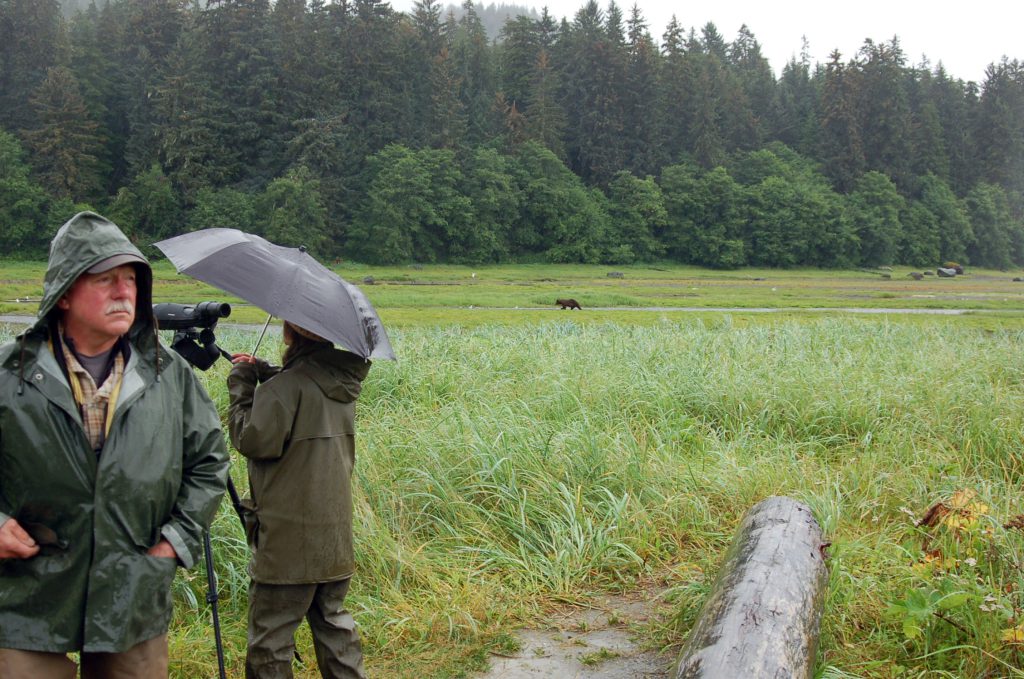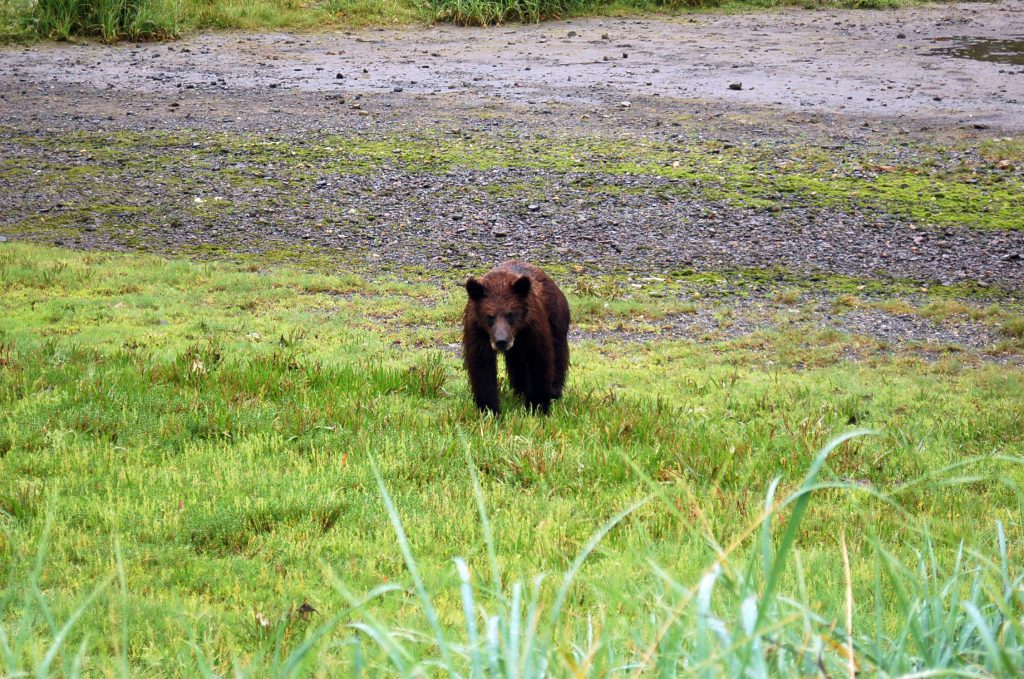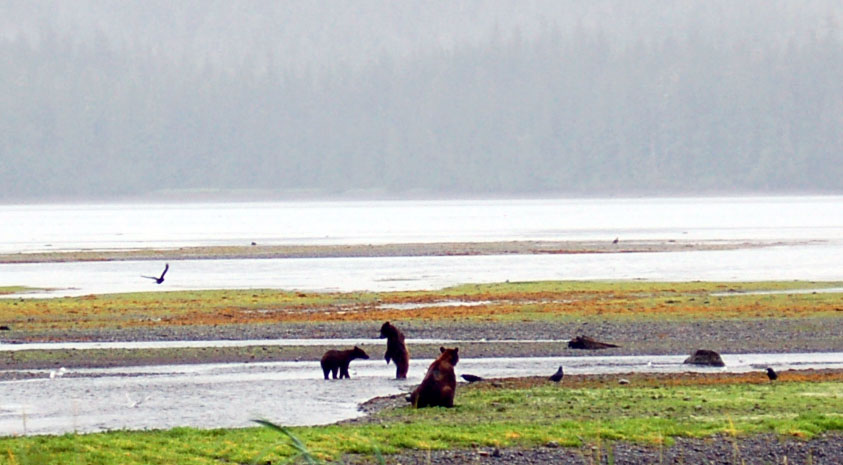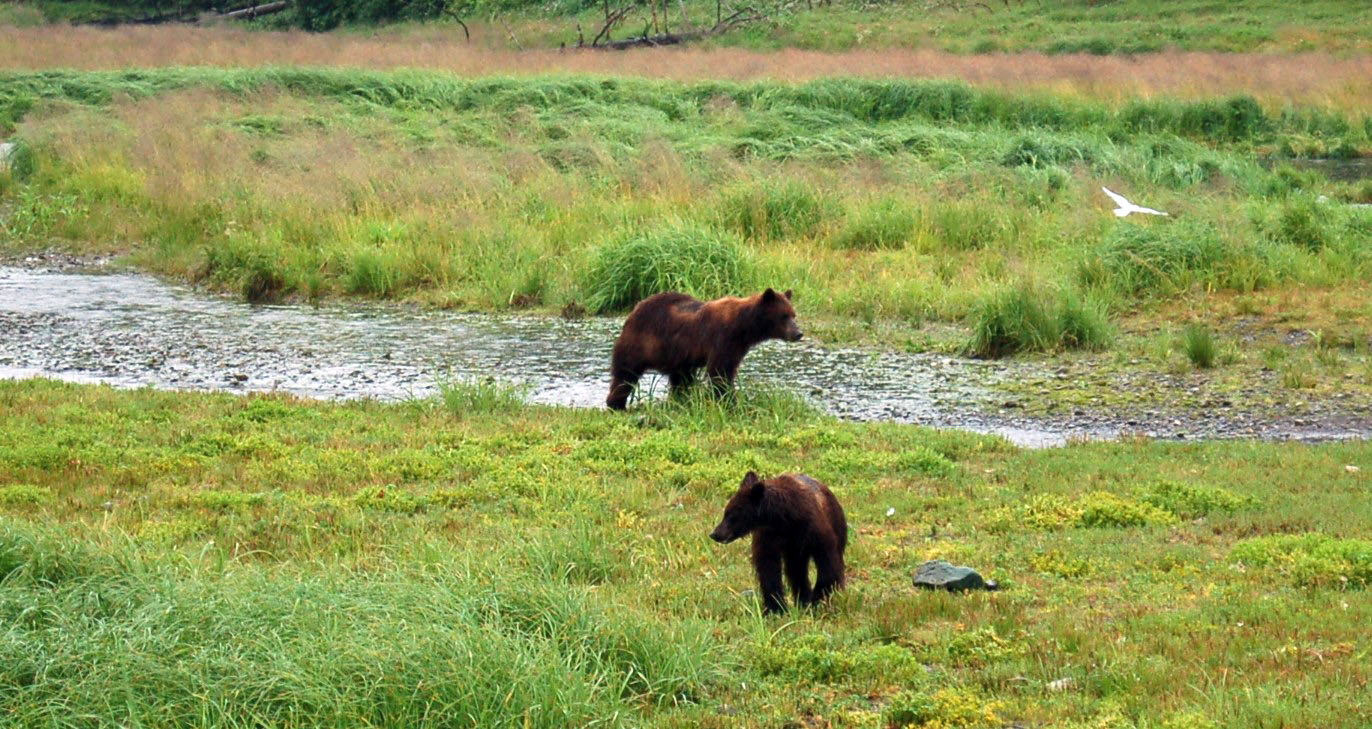With a reputation steeped in lore and a history marked by imperfections, the bruins of Admiralty Island find refuge and harmony.
by Amy Condra
This article was originally published in the Juneau Empire.
A brown bear sow and two cubs find repose on the banks of Pack Creek on Admiralty Island in July. “We manage Pack Creek so that our human presence is as benign as possible,” said Harry Tullis, U.S. Forest Service Lead Wilderness Ranger for Pack Creek. “We’re just a background to their normal activities.”
Raindrops drum on the Cessna’s aluminum floats, adding an urgent rhythm to our mission as one by one we ease ourselves out of the plane and into the shallows.
Clad in waterproof jackets and rubber boots we splash to shore, but reaching land doesn’t improve anything as far as the rain goes; there is no shelter as we stand on a gravel bar beneath a lowering sky.
Nobody is complaining, because our attention has been caught by something more compelling than the weather: Someone has spotted a bear.
“Oh my God!” exclaims a young woman in our group, as the rest of us squint and strain to make sense of a blurry shape far ahead of us.
I fumble for my binoculars, scanning the mud flat at Pack Creek.
And there it is: A brown bear walking along the stream’s rocky banks.
The animal moves in a way that seems almost casual. Then suddenly, swiftly, it plunges its paw into the creek; water flies in all directions as the bear pulls out a wriggling pink salmon.
We stand watching the bear, mesmerized, until our guide, Butch Laughlin, rousts us back into action.

“Let’s start walking,” he says, leading us in a single file line away from the safety of the float plane, toward the Pack Creek Bear Viewing Area in the Stan Price Wilderness Sanctuary. We make our way up a narrow strip between the wide-open beach and a shadowy forest.
This 60,000-acre sanctuary is located on the eastern shore of Admiralty Island, about 40 miles south of Juneau. It is cooperatively managed by the U.S. Forest Service and the Alaska Department of Fish and Game.
Its central feature, Pack Creek, descends 4,000 feet from the mountains into Seymour Canal.
Butch Laughlin of Alaska Fly ‘N’ Fish Charters has been guiding visitors to Pack Creek for 20 years. “Every spring when the bears came down from the mountains, here’s this guy and his wife living here,” Laughlin said, explaining Stan Price’s influence on the bears’ habituation. “The bears we see today, who have grown up coming here each summer, will pretty much ignore us.”
“Everything a bear wants is found in Seymour Canal,” writes U.S. Forest Service Wilderness Manager John Neary in “Pack Creek Bears and the Legacy of Stan Price,” a book produced by the Friends of Admiralty Island. “Arteries of tumbling streams bring masses of spawning salmon… and wash rich nutrients back downstream to clams along the beach… here on the convoluted edge of earth, where tree branches are washed by tidal surges, bear exist between two worlds of forest and ocean, drawing from the best of each to thrive in abundance.”
Butch and his wife, Sarah Dunlap, have been guiding people through this wilderness for 20 years; today their charges include me and three tourists from Montanna.
“Stay together, and don’t get too close to the woods,” Butch advises. “We try to give bears all the room they need.”
My adrenalin-infused enthusiasm at seeing a brown bear in the wild is fading into fear as I realize that I have chosen to put myself in a vulnerable position: One of these animals could easily reach out from the woods and knock me to the ground, with one forceful sweep of its paw.
A brown bear on Admiralty Island weighs between 450 – 650 pounds in the summer (and up to 900 pounds by autumn), has long claws ideally suited to tearing flesh, and boasts jaws powered by huge muscles on either side of its head.

I don’t know what it is that compels us to keep moving through bear country, instead of racing back to the safety of the South Spit where our plane is waiting to take us home. But if there is comfort in camaraderie, then it would be found in the knowledge that at Pack Creek, humans have historically been attracted to the bears.
As determined as my fellow voyeurs and I are to be observing brown bears here in their natural habitat, we aren’t exactly the first ones to do so. About 1200 people come to visit the bears every summer, says Harry Tullis, U.S. Forest Service Lead Wilderness Ranger for Pack Creek.
Four out of five of these visitors are non-Alaskans, he added; more than 10 percent are from outside the U.S.
“This had originally been a bear viewing area, ever since the 1930s,” Tullis said. “No bear hunting was allowed. Then in the 1950s, Stan Price pulled his wannigan out here, and his year-round presence became a big part of the habituation of the bears in Pack Creek.”
Since both food and hunting are banned in the sanctuary, said Tullis, bears do not perceive their human visitors as either sources of sustenance or as threats to their well-being; this is why it is easier, and safer, for people to see them at Pack Creek than anywhere else on the island.
It would be fitting, I think, if among the last manmade tracks on earth would be found the huge footprints of the great brown bear.
Earl Fleming, 1958
The sanctuary itself, which was created about ten years ago, is named after Stan Price, a logger and miner who, with his first wife Edna, brought his homemade wannigan, or floating cabin, to Pack Creek in the early 1950s.
At Pack Creek the Prices found a haven from the wind and the government officials of Juneau, both of which Stan found troublesome; he wound up staying here for nearly 40 years.
Living at Pack Creek meant living among bears, as Edna noted in her memoir, Nuggets from Thirty Five Years in Alaska: “We don’t trust any bears, at all. But we have lived in their home territory so long we have become well acquainted with them peaceably. And we thoroughly enjoy having them as neighbors.”
Stan and Edna welcomed visitors; Stan, especially, relished the opportunity to tell stories to those he sensed would appreciate them. His reputation as a raconteur attracted journalists and filmmakers, who documented Stan’s ease in the wilderness and his regard for the animals that dwell there.
He often told talked about Susie Bear, a cub they had cared for after her mother had been killed by a bruin; Susie Bear survived into adulthood and later returned to Pack Creek with her own cubs.
“At the time Stan was living out here and having those relationships with bears, he was telling people what they were like,” said Sarah Dunlap. “And it was not at all the idea people had of bears.”

When we reach the viewing spit, Butch points out Stan’s homestead, or at least what is left of it.
Stan died in 1989, and his house, as well as its outbuildings and gardens, is being reclaimed by the rainforest; it is already collapsing into decay, and soon it will have disappeared completely.
But Stan’s legacy here lingers; his respectful interaction with the bears he encountered at Pack Creek have created a place where people can watch bears that are used to, and will tolerate, the presence of people.
“Every spring when the bears came down from the mountains, here’s this guy and his wife living here,” explained Butch. “The sows begin bringing their cubs down here to fish, and they get used to humans being around. The bears we see today, who have grown up coming here each summer, will pretty much ignore us.”

This turns out to be true. For the next three hours, we observe as many as nine bears go about their daily lives.
They seem aware of our presence, but show no signs of being alarmed by it.
We, on the other hand, are enraptured by the bears; for the next 20 – 30 minutes, the relentless beating of the rain is now accompanied by a steady clicking of cameras punctuated by excited exclamations: “Yup, they’ve got big claws,” and “Those cubs have been playing for hours!” and “That little bear sure stands up a lot—it might have caught the scent of something.”
While such observations may seem obvious, they are a crucial first step in gaining a greater understanding of how bears behave.
These bears are several steps ahead of us; they already know what to expect from the people who come here, says Sarah.
Visitors to Pack Creek tend to be extremely predictable: We come together in small groups to stand at a designated spot for several hours and stare at bears. Occasionally we dig through our packs for cameras or binoculars, but that is about as varied as our routine gets.
“These are intelligent animals and they learn from their experiences,” said Sarah. “They incorporate the things in their landscape—and we’re just a thing in their landscape—into their lives, in whatever way that makes sense.”
“I think the most important thing that people sometimes fail to understand when they experience this area, is that even while they appear habituated, these are completely wild bears,” she added.
The Forest Service estimates that there are more than 1,600 brown bears on Admiralty Island, more than are found in all the Lower 48 states combined. The island itself is about 1,600 square miles in size; with an average of one bear per square mile, it has one of the highest densities of brown bears in the world.
Native Tlingits, who have shared their island with brown bears for centuries, call Admiralty “Kootznoowoo,” or “Fortress of the Bears.” The Russians called it “Fear Island,” most likely because there tends to be three times as many bears here as humans.
While no bears or people have been harmed at Pack Creek, the same cannot be said for other sites on the island.
In 1929, after Forest Service employee Jack Thayer was killed by a brown bear while scouting timber at Admiralty’s Eliza Bay, a sizable number of land developers and policy makers demanded that the animals be exterminated.
“We have too much to do to make room for settlers and industrial workers to permit this menace to hang over us,” declared a 1929 editorial in The Daily Alaska Empire. “The brown bears in the First Division ought to be exterminated—and the extermination work ought to begin at once.”
Not everyone agreed.
John Holzworth, a New York lawyer, came to Admiralty and photographed the island’s bears, and collected their hides and skulls for the New York Zoological Society. In 1930 he published “The Wild Grizzlies of Alaska,” an illustrated book that riled up “save the bear” sentiments both in Alaska and in the continental U.S.
For the next 50 years, a number of industries, government agencies and conservation groups endorsed varied, and occasionally competing, strategies for dealing with the bears of Admiralty Island.
In 1978 President Jimmy Carter declared Admiralty Island a National Monument; today about 937,000 acres of its land is designated as the Kootznoowoo Wilderness, which means that logging, road-building, and the construction of permanent structures are generally prohibited here.
This is where the Pack Creek Bear Viewing Area is located, and it is where bears and humans have, over time, learned to reach a sort of detente.
Four hours after arriving at the viewing spit, I haven’t yet tired of looking at the bears, of watching cubs tumble over each other in mock battle, of one sow strolling purposefully up and down the creek while another settles into the sedge grass to gaze out over the meadow.

These are bears in repose, taking a break from the roles they are often given in poetry and prose—that of fierce, formidable warriors, or imposing symbols of strength and solidity.
I don’t think those literary depictions tell the whole story.
Witnessing the daily routines of the bears at Pack Creek, routines filled with mundane tasks necessary for survival—fishing, napping, tending to their young— I realize that these bears are living lives that are not completely unlike my own.
”I can’t say what a bear’s worth. I can’t say what a bear’s good for,” Stan Price told reporter Sue Cross in 1988. “But I know they were here before we were.”
And after spending a day in their presence, and allowing my initial fear of these creatures to settle into regard tempered by respect, I hope the brown bears of Admiralty Island linger at least as long as we do.
“It would be fitting, I think,” wrote naturalist Earl Fleming in 1958, “if among the last manmade tracks on earth would be found the huge footprints of the great brown bear.”
